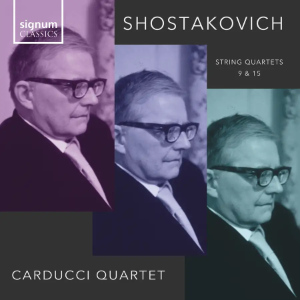
Dmitri Shostakovich (1906-1975)
String Quartet No. 9 in E flat, Op.117 (1964)
String Quartet No. 15 in E flat minor, Op.144 (1974)
Carducci Quartet
rec. 2021, Cedars Hall, Wells Cathedral School, Wells, UK
Signum Classics SIGCD786 [60]
This is Carducci Quartet’s third Shostakovich disc.They have recorded eight of the composer’s fifteen quartets, three of them a decade ago (review). If this is to be a full cycle, then they are in no hurry. In 2015, forty years after Shostakovich’s death, their project “Shostakovich15” saw them play ten complete cycles internationally. A day-long account at the Globe theatre in London is one of my great musical memories. They revisit the cycle fairly regularly.
This disc is all that one might expect from these players in this music. The Ninth and Fifteenth Quartets, though written ten years apart, match at least because both are multi-movement works that play continuously. The Ninth has a symmetrical plan, a central scherzo preceded and followed by two adagios, framed by faster music for the opening and closing movements. The scale of the outer movements differs, here four minutes for the first and ten minutes for the last. The score proposes overall twenty-six minutes: the Carducci take 26:13. The Beethoven Quartet, who premiered the quartets 2-14 with the composer’s input, take an often hasty-sounding 23:45, with a finale of nine minutes. Yet the Carducci never sound sluggish, even in the two adagios.
The matter of speed especially affects a well-known moment early in the third movement. Two bars after Figure 26, the first violin adopts the anapaest rhythm associated with Rossini’s Overture to William Tell (Shostakovich hints at the theme with just the accompanying metre for the final galop). The Beethoven Quartet are so fast that the metre is muddied, with little sense of the impulse from the repeated “two shorts and a long” of anapaests. The Carducci are precise and spritely here, tempting you to hum the missing tune. They are right: this sounds more musical and more characterful.
In theory, the Russian recording should carry more authority, but it is what comes to mind when one listens to this account. The Carducci observe the tranquillo marking of the first movement well enough with a relaxed opening. Yet, while tranquillity is never sustained for long in Shostakovich’s quartets, the music never turns tragic or protesting.
The Ninth is thought of as the start of a new style. Shostakovich moves from the rhetorical power of the Eighth toward music more ingratiating, sometimes lighter, but also more ambiguous or elusive. Satire and irony are never too far away. The Carducci are well attuned to this, and always responsive to the frequent shifts of mood and texture. The obsessive semitonal oscillation and harsh pizzicati of the fourth movement take us somewhere comfortless, if not quite tragic. The large-scale finale is resoundingly brought off by the players’ uncompromising approach. Harsh dissonances bite, and there is a willingness to produce a rough sound, when that is what the notes and markings imply.
The Fifteenth quartet is often seen as valedictory, as Shostakovich had been seriously ill. There is no dedicatee, so commentators wonder if he intended it for himself. Six movements played continuously are all marked Adagio; it is Adagio molto in the fifth-movement funeral march. That seems monotonous, but there are many kinds of motion, texture and harmonic tension within that constraint. His longest quartet, it takes the Beethoven Quartet 37:24. Shostakovich knew this would challenge players and listeners, but told the first performers: “play it so that flies drop dead in mid-air, and the audience starts leaving from sheer boredom”.
The Carducci Quartet play this climactic work of the cycle with the dedication it demands. Their overall time of 34:05 seems about right. To take 32 minutes is not unknown, as did the Mandelring Quartet on Audite, and it never felt too swift. But the Carducci find speeds that feel right, and allow them (when needed) to achieve the paradox – as in the opening Elegy – of combining a senses of stasis with a discernible onward pulse. There are passage of great beauty in this music, and in this acount the opening Elegy is a fugue of timeless eloquence.
The second movement Serenade begins with a sort of anti-musical effect, a succession of ppp to sffff crescendi on single notes passed between the instruments. These players make the passage quite fierce, even chilling. The funeral march has an ominous tread, and the various solos for first violin, viola and cello are expressively done (after its initial Adagio molto indication, the only marking is espressivo). The closing Epilogue’s scampering demisemiquaver runs, in first violin, then cello, then everybody, are very athletically played. Marine Frolova-Walker in her excellent booklet note likens this to the “wind over the graves” finale of Chopin’s Second Piano Sonata, which also follows a funeral march. The last quartet ends – like numbers 3-7, 10-11 and 14 – with the marking morendo (dying). This performance is haunting right up to that moment.
Shostakovich’s Fifteenth and final quartet, premiered on November 15th 1974, will soon be fifty years old. The Carducci Quartet, perhaps aware of this, and released this recording, made back in 2021, to honour the anniversary of the conclusion of this great cycle. Whatever their intention, the fine performances on this well-recorded disc are a worthy tribute.
Roy Westbrook
Previous review: Néstor Castiglione (May 2024 Recording of the Month)
Buying this recording via a link below generates revenue for MWI, which helps the site remain free




















